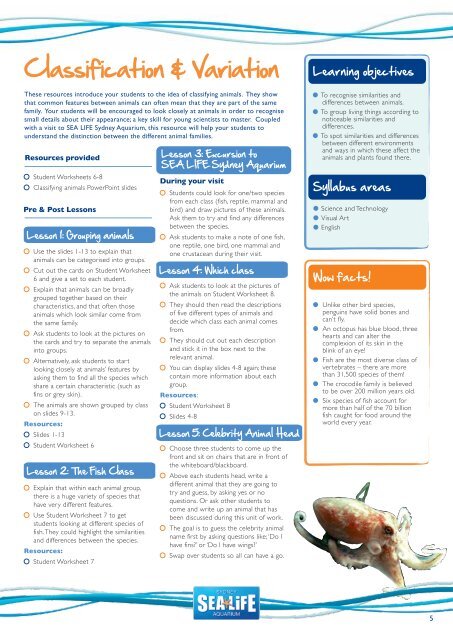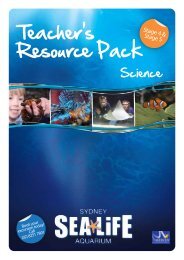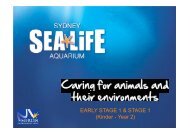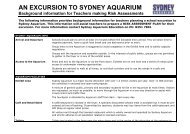Teacher's Resource Pack - Sydney Aquarium
Teacher's Resource Pack - Sydney Aquarium
Teacher's Resource Pack - Sydney Aquarium
You also want an ePaper? Increase the reach of your titles
YUMPU automatically turns print PDFs into web optimized ePapers that Google loves.
C lassification & Variation<br />
These resources introduce your students to the idea of classifying animals. They show<br />
that common features between animals can often mean that they are part of the same<br />
family. Your students will be encouraged to look closely at animals in order to recognise<br />
small details about their appearance; a key skill for young scientists to master. Coupled<br />
with a visit to SEA LIFE <strong>Sydney</strong> <strong>Aquarium</strong>, this resource will help your students to<br />
understand the distinction between the different animal families.<br />
<strong>Resource</strong>s provided<br />
Student Worksheets 6-8<br />
Classifying animals PowerPoint slides<br />
Pre & Post Lessons<br />
Lesson 1: Grouping animals<br />
Use the slides 1-13 to explain that<br />
animals can be categorised into groups.<br />
Cut out the cards on Student Worksheet<br />
6 and give a set to each student.<br />
Explain that animals can be broadly<br />
grouped together based on their<br />
characteristics, and that often those<br />
animals which look similar come from<br />
the same family.<br />
Ask students to look at the pictures on<br />
the cards and try to separate the animals<br />
into groups.<br />
Alternatively, ask students to start<br />
looking closely at animals’ features by<br />
asking them to find all the species which<br />
share a certain characteristic (such as<br />
fins or grey skin).<br />
The animals are shown grouped by class<br />
on slides 9-13.<br />
<strong>Resource</strong>s:<br />
Slides 1-13<br />
Student Worksheet 6<br />
Lesson 2: The Fish Class<br />
Explain that within each animal group,<br />
there is a huge variety of species that<br />
have very different features.<br />
Use Student Worksheet 7 to get<br />
students looking at different species of<br />
fish. They could highlight the similarities<br />
and differences between the species.<br />
<strong>Resource</strong>s:<br />
Student Worksheet 7<br />
Lesson 3: Excursion to<br />
SEA LIFE <strong>Sydney</strong> <strong>Aquarium</strong><br />
During your visit<br />
Students could look for one/two species<br />
from each class (fish, reptile, mammal and<br />
bird) and draw pictures of these animals.<br />
Ask them to try and find any differences<br />
between the species.<br />
Ask students to make a note of one fish,<br />
one reptile, one bird, one mammal and<br />
one crustacean during their visit.<br />
Lesson 4: Which class<br />
Ask students to look at the pictures of<br />
the animals on Student Worksheet 8.<br />
They should then read the descriptions<br />
of five different types of animals and<br />
decide which class each animal comes<br />
from.<br />
They should cut out each description<br />
and stick it in the box next to the<br />
relevant animal.<br />
You can display slides 4-8 again; these<br />
contain more information about each<br />
group.<br />
<strong>Resource</strong>s:<br />
Student Worksheet 8<br />
Slides 4-8<br />
Lesson 5: Celebrity Animal Head<br />
Choose three students to come up the<br />
front and sit on chairs that are in front of<br />
the whiteboard/blackboard.<br />
Above each students head, write a<br />
different animal that they are going to<br />
try and guess, by asking yes or no<br />
questions. Or ask other students to<br />
come and write up an animal that has<br />
been discussed during this unit of work.<br />
The goal is to guess the celebrity animal<br />
name first by asking questions like; ‘Do I<br />
have fins?’ or ‘Do I have wings?’<br />
Swap over students so all can have a go.<br />
Learning objectives<br />
● To recognise similarities and<br />
differences between animals.<br />
● To group living things according to<br />
noticeable similarities and<br />
differences.<br />
● To spot similarities and differences<br />
between different environments<br />
and ways in which these affect the<br />
animals and plants found there.<br />
Syllabus areas<br />
● Science and Technology<br />
● Visual Art<br />
● English<br />
Wow facts!<br />
● Unlike other bird species,<br />
penguins have solid bones and<br />
can’t fly.<br />
● An octopus has blue blood, three<br />
hearts and can alter the<br />
complexion of its skin in the<br />
blink of an eye!<br />
● Fish are the most diverse class of<br />
vertebrates – there are more<br />
than 31,500 species of them!<br />
● The crocodile family is believed<br />
to be over 200 million years old.<br />
● Six species of fish account for<br />
more than half of the 70 billion<br />
fish caught for food around the<br />
world every year.<br />
5








